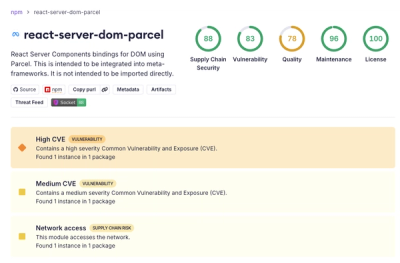
Security News
Deno 2.6 + Socket: Supply Chain Defense In Your CLI
Deno 2.6 introduces deno audit with a new --socket flag that plugs directly into Socket to bring supply chain security checks into the Deno CLI.
@plotdb/csscope
Advanced tools
add custom scope to any css. Use browser thus only works in browsers.
install via npm:
npm install --save @plotdb/csscope
then, include csscope.js, and convert css as follow:
scopedCSS = csscope("desired-scope-name", "your-css-code")
or, with object as option:
scopedCSS = csscope({css: "your css code", name: "desired-scope-name", scopeTest: "..."})
or, create a converter to convert:
scope = new csscope.converter({ scopeTest: '...' });
var scopedCSS = scope.convert({ ... });
options:
.your-scope-namescopeTest is a css selector rule for which if certain node matches then it's the root of a scope.
This is used to identify scope boundary in DOM, according how users label and identify the root element of scopes by their implementation.
For example, following DOM ( in Pug ) use [ld-scope] to separate each scope:
div(ld-scope,scope-id="0a2c92a0e7e82")
h2 This is the root scope.
div(ld-scope,scope-id="4c26846e44f68")
h2 This is a child scope.
when we specify scopeTest option, we can ensure that the style for h2 element in the parent won't affect h2 element in its child.
scopeTest is by default undefined (or by default the value specified in option when calling csscope.converter constructor), in this case there is no scope boundary so all parent rules penetrate into their children.
To style element of scope root, simply use :scope pseudo class:
:scope { background: #000; color: #fff}
csscope will replace :scope with the corresponding scope selector.
use csscope.manager for managing library version and cache. usage:
csm = new csscope.manager(options)
where options is an object with following posisble fields:
registry: a registry object telling manager how to fetch requested resource. can be either
csscope.manager uses it as a root path to construct a resource URL.{name, version, path} parameters. return an URL for specific moduleurl({name, version, path}): return an URL for specified item.fetch({name, version, path}): optional, return {version, content} for specified item.
version: exact version of the returned contentcontent: content of the requested resource@plotdb/block and @plotdb/registry module.Generate js / css files and use csscope.cache to preload assets.
Load from JS:
csscope.cache({inited: false, code: 'scoped-css-code', scope: 'scope-name'});
Load from CSS:
script csscope.cache({inited: true, scope: 'scope-name'});
style: include bundle.css
Test against all major browsers.
MIT
FAQs
add scope to any css code
We found that @plotdb/csscope demonstrated a healthy version release cadence and project activity because the last version was released less than a year ago. It has 1 open source maintainer collaborating on the project.
Did you know?

Socket for GitHub automatically highlights issues in each pull request and monitors the health of all your open source dependencies. Discover the contents of your packages and block harmful activity before you install or update your dependencies.

Security News
Deno 2.6 introduces deno audit with a new --socket flag that plugs directly into Socket to bring supply chain security checks into the Deno CLI.

Security News
New DoS and source code exposure bugs in React Server Components and Next.js: what’s affected and how to update safely.

Security News
Socket CEO Feross Aboukhadijeh joins Software Engineering Daily to discuss modern software supply chain attacks and rising AI-driven security risks.